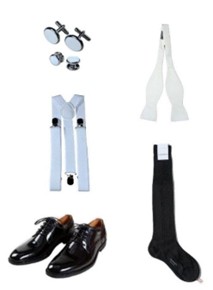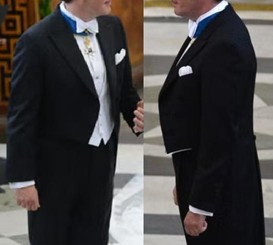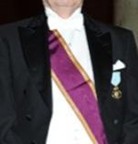Purpose of the Dress Code
Throughout history, dress codes have served to guide guests in selecting attire that is appropriate to the occasion, thereby fostering a sense of comfort and cohesion among all attendees. Observance of the prescribed dress code is a gesture of courtesy towards fellow guests and, in our context, towards the Order. It ensures a dignified and harmonious gathering.
The General Conclave therefore respectfully requests that all Guests, Members, and Recipients adhere to the Order’s dress code, in the interest of decorum and collective enjoyment.
Prescribed Attire
The Order’s dress code stipulates formal civilian or military attire. For gentlemen, formal civilian dress is defined as white tie (evening tailcoat), national costume, or clerical robe.
Constituents of Full Evening Dress (White Tie)
A complete white tie ensemble shall comprise:
- A black tailcoat with silk-faced lapels.
- Black trousers with silk side braids.
- A white shirt with a stiffened front and starched cuffs.
- A white formal waistcoat.
- Braces, if required (belts are not appropriate).
- Shirt studs and cufflinks.
- A white bow tie (preferably self-tied, though pre-tied versions are acceptable)
- A white pocket square.
- Black formal socks, preferably of silk or fine cotton, long enough to ensure no skin is visible when seated.
- Patent leather shoes or opera pumps; alternatively, impeccably polished plain black Oxford shoes may be accepted.

Ideal Fit and Presentation
in a properly tailored ensemble:
- The waistcoat should conceal the trouser waistband.
- The waistcoat should not extend below the tailcoat.
- Shirt cuffs should protrude approximately 1 cm beyond the coat sleeves.
- The shirt and coat collar should discreetly conceal the rear of the bow tie.

Items Inappropriate for White Tie
- Gloves are not to be worn indoors with formal evening dress.
- Wristwatches are discouraged, as consulting the time may be perceived as discourteous. A discreet pocket watch, secured with a chain and kept in the waistcoat pocket, is a suitable alternative.
- Loafers, sneakers, or casual footwear.
- Brogued leather shoes.
- Shoes in brown, blue, or other colours.
- Socks in white or any colour other than black.
Order Decorations
- First-degree decorations are worn over the heart.
- Sashes are worn over the right shoulder and beneath the coat.

- Only official orders and medals may be worn in addition to the decorations of the Order of Innocence. Decorations from charitable societies, however commendable their work, are not permitted on the Day of Solemnity. These include: Military Order of the Collar (M.O.C.), Order of Saint Lazarus, Knights Templar, Ordo Sancti Constantini Magni, Austrian Albert Schweitzer Society, among others.
- No Grand Cross sashes from other Orders may be worn in conjunction with the Order of Innocence’s grade sash.
Additional Considerations
- Footwear is among the most prominent elements of formal attire. Worn, unpolished, or soiled shoes detract from the overall impression and may be perceived as a lack of respect for the occasion and company.
- Please note: tuxedos (black tie) or dark lounge suits do not constitute formal evening dress.
Military Dress
Military attendees, including officers, non-commissioned officers, squad leaders, soldiers, and sailors, shall wear full dress uniform as prescribed by the regulations of their respective nations. No weapon-related items may be worn.
A Final Reflection
Proper attire elevates the solemnity of the occasion and conveys respect for both the Order and fellow celebrants.
Enquiries
Should You require further guidance or clarification, You are most welcome to contact:



